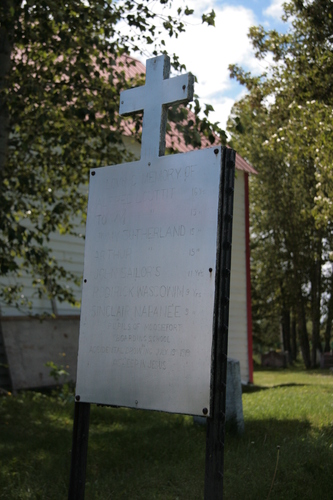
MOOSE FACTORY – Deaths of indigenous students under the care of the Church and the Indian Affairs Departments were a reality throughout the residential school era. There were official forms that were to be filled out by the principal of the school on such occurrences. Some were and some were not.
The archives of the Indian Affairs Department contain several examples although the number of reports. This number versus the actual deaths at these schools across the country, do not jive, meaning details surrounding many more deaths and disposal of the bodies of students while attending these schools are left to speculation.
The startling lack of medical attention many these sick students received, even when records were kept, may explain at least part of the national student death toll at Indian Residential Schools. Other deaths can be directly attributed to neglect.
One such report involves Reverent Haythornwaite, Rector of the Moose Factory Residential School. The following report was filed to Duncan Campbell Scott from the district manager of Indian Schools.
The report was dated September 19, 1919.
“I regret to have to report a very serious drowning incident in this district. It occurred on July 29th, at Moose Factory. It appears that twelve of the school children from the church of England Mission of which The Rev Haythornwaite is in charge, were allowed to crowd into an old canoe, for the purpose of crossing to an island to pick berries. It was high tide with quite a big sea running. Then, at about mid-channel, the canoe capsized and seven out of twelve children were drowned. The remaining five were saved by an Indian named Archie Sailer who, in a small canoe, managed to pick them up. The head of the servants at the school sent out his entire staff with all canoes available, to search for the bodies and by 1 a.m. on the 30th, the seven bodies were recovered. Two of the boys drowned were sons of one of our servants.”
To deflect criticism, one of the children, John Carpenter, was given great honour for saving the life of another student during that horrible incident with an award sponsored by the Royal Humane Association. According to the accompanying document, the medal was given for unusual bravery.
Years later, in August of 1921, Reverend Haythornwaite, ended his own life with a gun, as reported in the Cochrane Morning Citizen. After breaking his shoulder while moving a piano, Rev Haythornwaite could not get to the nearest hospital and was left untreated for weeks. The closest hospital was 180 miles away in Cochrane and he was in too much pain to travel. He was also diagnosed as having the early signs of Dementia.
There were a few Indigenous medicine men treating him and caring for him, but the pain was too much to bear, and the Reverend escaped from their constant care long enough to find and use his private pistol to end the agony.
Although there is no direct evidence of it, it is very likely that under the extreme pain, he also added his deep-seated remorse about the drowning of the children under his care years earlier.
Those listed as drowned on that day were Alfred Louttit, 16; his brother Tom, 15; twin brothers Jimmy and Arthur Sutherland, 15; John Sailors, 11; Roderrick Wascowin, 9, and Sinclair Napanee, also 9.







